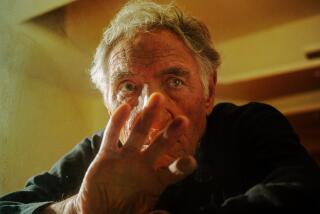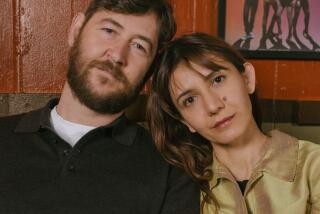Why ‘Doctor Sleep’ had to end at ‘The Shining’s’ Overlook Hotel
Director Mike Flanagan and producer Trevor Macy on re-creating the Overlook Hotel, casting “The Shining” doppelgängers and necessary diversions from Stephen King’s book in “Doctor Sleep.”
Warning: Spoilers ahead for the film version of “Doctor Sleep,” now playing in theaters nationwide, and how it differs from Stephen King’s novel.
Re-creating the labyrinthine Overlook Hotel for “Doctor Sleep,” director Mike Flanagan’s follow-up to Stanley Kubrick’s 1980 classic “The Shining,” was a task the filmmakers knew they had to get right.
Flanagan, a self-described superfan of both Kubrick and King’s, was both daunted and excited by the extra pains it took to capture every detail of the imposing hotel — an iconic location in the horror canon.
“If any other filmmaker had been out there re-creating Kubrick’s sets and shots, I knew that I would be scrutinizing every frame and every little detail,” he said. “So I knew people would be doing that to me, and that scared me to death.”
But it was also incredibly rewarding, he said, “because I got to walk into the Overlook Hotel and it’s like walking into your own memory. I knew where everything was, it was crazy. It was like being a kid again. I got to put my camera in the exact place that Kubrick put his, like forensic film school. That was a thrilling education and made me understand and appreciate him as a filmmaker and ‘The Shining’ in ways I never would’ve under any other circumstances.”
Picking up directly on the heels of “The Shining,” the majority of “Doctor Sleep” follows as an adult Danny Torrance (Ewan McGregor) struggles to overcome the alcoholism and rage that beset his father, Jack. After achieving sobriety, he takes on the role of mentor to Abra Stone (Kyliegh Curran), a teenage girl who “shines” as he did as a kid.
The return to the Overlook in the film’s third act is one of two major differences between the movie and its 2013 source material, the other being Dan’s ultimate fate.
“The adaptation is pretty faithful to the book with the exception of the location and mechanics of the third act,” said producer Trevor Macy.
“Doctor Sleep” director Mike Flanagan on Stephen King and creating a follow-up to “The Shining” and following in the footsteps of both Stephen King and Stanley Kubrick.
“I knew once we were bringing back the Overlook we were changing the ending,” said Flanagan. “King has been very specific about what he doesn’t like about ‘The Shining,’ and one of the things he was upset about was changing the ending.”
In King’s version of “The Shining,” Jack Torrance sacrifices himself to save Danny and his wife Wendy as the ghosts of the hotel struggle to possess him. Instead, Flanagan gave that fate to Dan as a way of reconciling the differences between King’s book and Kubrick’s film.
“I had the opportunity to reach past the Kubrick film all the way back to the ending of ‘The Shining’ the novel, the ending that King never got,” he said. “And I thought if I could take [Jack’s] ending and give it to Dan, there was a beautiful symmetry in that.”
“It also made sense in the context of the story,” said Macy. “We were returning to the place where the trauma was inflicted. The fact that he doesn’t pass it on was pretty powerful from a character point of view.”
“I really did look at this as a generational story,” said Flanagan. “I looked at Dan and Abra like Hallorann and Danny. That it was a cycle. I thought there was symmetry that kind of required [Dan’s sacrifice] to truly hand off this baton to Abra.”
Casting actors who could call to mind Jack Nicholson, Shelley Duvall, Scatman Crothers and Danny Lloyd — the core performers in Kubrick’s film — was nearly as challenging as re-creating the hotel.
“Casting was one of the most daunting elements of this project,” said Flanagan. “There were two options out the gate: recasting or trying to re-create the actors digitally.”
But opening the movie with a digitized version of Danny Torrance riding a big wheel through the hotel felt too inauthentic, he said. “I’d be making a video game and it felt like theft. That was the thing that felt like a bridge too far.”
Instead, he applied the same guideline toward casting as he did to re-creating the hotel, opting to capture the essence of the original without seeking to replicate it exactly. “We’re trying to remind the viewers of those characters,” he said. “And it was really hard with Jack.”
Ewan McGregor plays an all-grown-up Danny Torrance in an inspired horror-fantasy that seeks to reconcile Stephen King and Stanley Kubrick.
In order to relieve some of the pressure of living up to Nicholson’s performance, Flanagan decided to include Jack Torrance as a spirit of the hotel rather than the alcoholic writer we see through most of “The Shining.” He cast Henry Thomas, who he had worked with on the Netflix series “The Haunting of Hill House.”
“I wasn’t looking for someone to do a Nicholson impression,” said Flanagan. “I was looking for someone to play Lloyd the bartender. It seemed like the most respectful way to go.”
McGregor was chosen to play an adult Dan because “he carries with him as a person and as an actor a palpable sense of humility and earnestness,” said Flanagan. “If you look at Jack Torrance as the embodiment of toxic masculinity, Dan Torrance embodies vulnerable masculinity. And I thought Ewan brought that in a really profound way.”
As for Alex Essoe as Wendy Torrance and Carl Lumbly as Dick Hallorann, “We wanted people who are not permutations but who would create a sense of familiarity for people who know these characters so well,” said Macy. “They were [similar but] indicative of the fact that this movie is a little different. We’re not trying to do an exact knockoff.”
The 13-year-old star of “Wonder” and “Good Boys,” Jacob Tremblay, takes on a particularly horrifying role in the Stephen King adaptation “Doctor Sleep.”
More to Read
Only good movies
Get the Indie Focus newsletter, Mark Olsen's weekly guide to the world of cinema.
You may occasionally receive promotional content from the Los Angeles Times.











